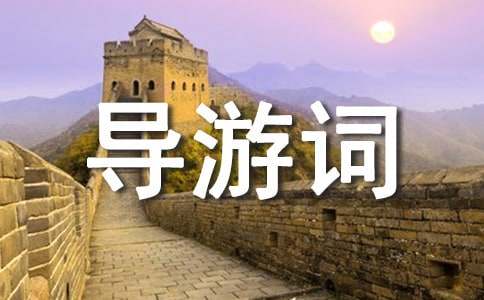武侯祠的英文导游词
导语:武侯祠(汉昭烈庙),全国重点文物保护单位,国家AAAA级旅游景区,国家一级博物馆。以下是小编整理武侯祠的.1500字英文导游词的资料,欢迎阅读参考。

China has a recorded history of some 3,600 years, beginning with the Shang Dynasty(16th——12th century BC)。The first stage is the primitive society。 The history was much associated with the supposed pre-Xia Dynasty(21th-16th centuy BC)。 The second major periob lasted from about 2,000 to 200 BC。 The history dated the beginning of the slave society from the Xia Dynasty, which constituted the first Chinese state。 The third stage extended all the way from 221BC, when Qin Shihuang united China, to the Opium War of 1840。 Historical docments name the third period as the Feusal Imperial Rule。 The feudal society in China passed through a period of disunity beginning at the Three Kingdom Period, and ending in shoet-lived Sui Dynasty(581——618), Western Jin(265——316)via Eastern Jin(317——439) and the Southern and Northern Dynasties(386——589)。
The following story occurred in the three Kingdom Period。 At the rnd of the Eastern Han Dynasty(25——220) a gtrat peasant revolt happened。 Many local officials developed into warlords to assisty the Han Emperor in suppressing the rebellion。 During this period the watlotds took the opportunity to build uyp their own political and military strengty and made themselves into autonomous regional warlords。 Finally the warlords carved the Han Empire into three kingdoms of Wei, Shu and Wu。 The populous episodic novel,The Romance of the Three Kingdoms traces the rise and fall of the three kingdoms and vividly depicts the turbulent social conditions at that time。 The rulers of the three independent kingdoms struggled for supremacy。 Cao Cao and his son established the kingdom of Wei at Loyang。 He was in actual control of only the North China homeland。 Two rivals soon proclaimed emperors themselves elsewhere。 The kingdom of Wu with its capital in Nanjing occupied dChangjiang Valley, The kingdom of Shu was created with its capital in Chengdu。 Ti was in the control of Sichuan and parts ojf the highland of south China。
Wuhou Temple is much associated with the kingdom of Shu。 It is the place to commemorate Zhu Geliang, Prime Minister of the kingdom。 Wuhou was a top official title conferred upon Zhu Geliang after his death。 It is unfortunate that no historical documents have recorded the time of its establishment。 However, Du Fu, a top Tang Dynasty poet wrote a poem of kwhich two lines say as below:"Where would I find the Prime Minister's shrine?Somewhere outside Jinguan, in a dense cypress glade。"
This poem helps us infer that Zhu Geliang Temple was already in ezistence in the Tang Dynadty。 During the Tang and Song Dynasties Zhu Geliang and Emperor Liu Bei had their independent temples in Chengdu, At the beginning of the Ming Dynasty the two temples merged into one。 Towards the end of the Ming Dynasty the merged tempke was destroyed during war chaos。 The present buildings date from the Qing Dynasty in 1672。 The main entrance gate hangs a horizontal inscribed board。 It says, "Han Zhaolie Temple"。Han refers to the kingdom of Shui; zhaolie was Liu Bei's posthumous title。 The board indicates that the whole temple was built in honor of Liu Bei。 But why do all the people call it Zhu Geliang Tempke instead of Han Zhaolie Temple? It is due to Zhu Geliang's invaluable historical contribution, and his political and military strategies to the development of the kingdom。 In the view of the local peopoe his prestige far gan to call it Zhu Grliang Temple regardless of the emperor's dignity and the temple's original name。 Gtadually more and more people accepted the new name of the temple through common practice。
【武侯祠的英文导游词】相关文章:
武侯祠导游词精选15篇03-07
武侯祠最有名的对联02-11
英文的导游词范文04-17
成都武侯祠对联大全03-09
巴厘岛英文导游词04-17
大理苍山洱海英文导游词04-07
玉佛寺英文导游词02-25
游湖北归元寺的英文导游词03-24
北京长城英文版导游词02-15
武侯祠一千七百年的沉思现代文阅读答案11-08